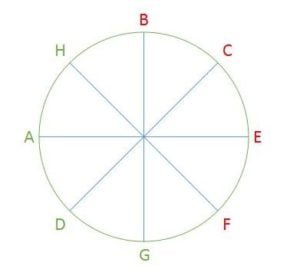|
Reasoning Puzzle Questions and Seating Arrangement Questions : Reasoning Puzzle Questions and Seating Arrangement Questions are usually asked in all competitive exams like IBPS PO, IBPS Clerk, SBI PO, SBI Clerk, RRB PO, RRB Clerk, LIC, RBI, CAT, MBA, etc. |
Set-1
Eight persons A, B, C, D, E , F, G and H are sitting around a circular table. 4 of them are facing towards the centre and 4 of them are facing away from the centre. Further, the following information is known:
B is sitting second to the left of both A and E. H is sitting to the immediate left of both A and B. A is facing the centre. D is sitting third to the right of E. G and E are not sitting adjacent to each other. H, D and G face the same direction (I.e, towards the centre or away from the centre). C is not sitting adjacent to G.
1. Who is sitting third to the left of F?
2. Who is sitting second to the right of C?
3. Who is sitting opposite to D?
4. Who is sitting second to the right of D?
5. For how many members, the direction they face can be uniquely determined?
Set-2
8 friends A, B, C, D, E, F, G and H are sitting on a row facing the north. Each one of them has a different number of coins among 1, 2, 3, 4, 5, 6, 7 and 8, not necessarily in the same order. Further, the following information is known.
4 persons are sitting between A and B. A is neither the first nor the last person in the row. The number of coins with the person sitting at the left extreme is equal to the sum of the number of coins with A and B. E has 2 coins and is sitting in the right-most seat. A is not a neighbour of E. 3 persons are sitting between F and G. F has 2 more coins than G. G is not a neighbour of A. H is not a neighbour of G. The sum of the number of coins with C and D is 13. C has more coins than D. The number of coins with H is equal to the sum of the number of coins with F and G. C is sitting adjacent to H. A has more coins than B.
6. What is the number of coins with F?
7. The sum of the number of coins with E and B is equal to the number of coins with
8. What is the sum of the number of coins with the persons sitting adjacent to H?
9. Who is sitting third to the right of the person with 4 coins?
10. For how many persons, the number of coins with the person is less than the number of coins with both of his neighbour(s)?


Hi! Do you know if they make any plugins to assist with SEO?
I’m trying to get my site to rank for some targeted keywords but I’m
not seeing very good gains. If you know of any please share.
Many thanks! You can read similar text here: Blankets
Hindi me karva dijiye please sir
Hindi me karva dijiye please sir
In 2nd question, what about Naveen , Ritesh and Tushar’s Seating Position ?
Good day! Do you know if they make any plugins to help with Search Engine
Optimization? I’m trying to get my website to rank for some targeted keywords but I’m not seeing very good success.
If you know of any please share. Kudos! You can read similar text here: Change your life
I’m really inspired along with your writing abilities as smartly as with the format in your weblog. Is that this a paid subject or did you customize it your self? Anyway keep up the excellent high quality writing, it’s rare to peer a nice weblog like this one today. I like gkquestionsguru.com ! It is my: Tools For Creators
I’m extremely impressed together with your writing talents as smartly as with the structure on your blog. Is that this a paid theme or did you modify it your self? Anyway keep up the excellent high quality writing, it’s uncommon to peer a nice blog like this one today. I like gkquestionsguru.com ! My is: Stan Store